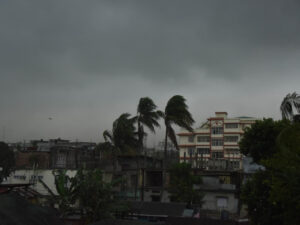At least 69 people have tragically lost their lives as powerful thunderstorms swept across parts of India and Nepal. The severe weather, marked by intense lightning, heavy rainfall, and strong winds, caused widespread destruction—damaging homes, uprooting trees, and disrupting transportation and electricity networks. In India, the states of Bihar, Uttar Pradesh, and West Bengal were among the worst hit, with dozens of fatalities reported due to collapsed structures and lightning strikes. Nepal also experienced severe impacts, particularly in its southern and central regions, where rural communities bore the brunt of the storm’s fury.
Authorities in both countries have launched rescue and relief operations to aid affected communities. Meteorological departments had issued warnings, but the sudden intensity of the storms caught many off guard. These tragic incidents highlight the growing vulnerability of South Asia to extreme weather events, often intensified by climate change. Governments are now focusing on rapid emergency response and long-term strategies to minimize the human toll from such natural disasters. As search efforts continue, the priority remains saving lives and providing immediate relief to survivors.
Introduction: Severe Thunderstorms Strike South Asia

Recent severe thunderstorms and lightning strikes have wreaked havoc across India and Nepal, leaving at least 69 people dead and dozens injured. The freak weather events occurred over 48 hours, primarily affecting rural and semi-urban regions where infrastructure is less equipped to withstand natural disasters. These storms caused widespread devastation, bringing down trees, damaging homes, and disrupting daily life.
The incidents have sparked national concern, prompting both governments to issue alerts and begin emergency relief operations.
Casualties and Affected Regions in India
In India, the worst-hit states include Uttar Pradesh, Bihar, Jharkhand, and Odisha. Over 50 people lost their lives due to lightning strikes, wall collapses, falling trees, and flying debris caused by strong winds.
-
Uttar Pradesh reported over 30 fatalities, primarily due to lightning and collapsing roofs.
-
In Bihar, at least 12 people died, many of them farmers working in the fields.
-
Jharkhand and Odisha witnessed multiple injuries and infrastructure damage.
Causes Behind the Sudden and Intense Weather
Meteorological experts attribute these violent thunderstorms to a combination of pre-monsoon atmospheric instability and excessive surface heating, which caused the rapid formation of cumulonimbus clouds. These clouds are typically responsible for the following:
-
Heavy rainfall in short periods
-
Strong, gusty winds (up to 80 km/h)
-
Hailstorms in isolated areas
-
Intense lightning activity
Rescue and Relief Operations

Both India and Nepal quickly launched rescue and relief operations:
-
In India, state disaster response teams and the NDRF were deployed with food, water, medical kits, and temporary shelters.
-
In Nepal, the Nepal Army and police personnel were mobilized to conduct rescue missions and clear debris.
-
Temporary relief camps have been set up for displaced families, and financial compensation for the families of the deceased has been announced in several Indian states.
Government Response and Compensation
The governments of India and Nepal have expressed grief and pledged assistance to the victims’ families:
-
Indian Prime Minister Narendra Modi and state chief ministers have extended condolences and announced ex-gratia payments of ₹4 lakh (approx. $4,800) to the next of kin of each deceased.
-
Nepali Prime Minister Pushpa Kamal Dahal (Prachanda) assured swift relief and has asked local bodies to prioritize support for the injured and displaced.
-
Both countries are also reviewing early warning systems and community preparedness programs to better mitigate future disasters.
Recurring Pattern of Lightning Fatalities in South Asia
Thunderstorm-related deaths, mainly due to lightning, are not new to South Asia. Every year, hundreds die, especially in rural areas where people work in open fields or live in houses without proper grounding or lightning protection.
According to India’s National Crime Records Bureau (NCRB), lightning strikes kill more people annually than any other natural disaster in the country. Similar patterns are noted in Nepal, especially during the pre-monsoon (April–June) and monsoon (July–September) periods.
This raises the need for:
-
Public awareness campaigns
-
Installation of lightning rods
-
Education on safety protocols during storms
A Wake-Up Call for Disaster Preparedness
The tragic loss of 69 lives due to thunderstorms in India and Nepal serves as a grim reminder of the vulnerability of millions to climate-induced disasters. While these are natural phenomena, timely warnings, adequate shelter, and community preparedness can significantly reduce casualties.

As climate change intensifies weather anomalies, both nations must invest in better meteorological tools, infrastructure, and disaster education to prevent similar tragedies in the future.
Devastation in Nepal: Lives Lost and Communities Affected
Nepal reported at least 19 deaths as a result of the same thunderstorm system that swept across northern India. The majority of casualties occurred in Terai regions bordering India, such as Bara, Parsa, and Rautahat districts, where thatched houses and temporary shelters collapsed during the storm.
The Nepalese Home Ministry confirmed that dozens were injured, with many currently undergoing treatment in overwhelmed medical centers. The storms have affected power supplies, communication lines, and local transport, complicating rescue efforts.
Frequently Asked Questions
How many people died in the recent thunderstorms?
At least 69 people have died in India and Nepal.
Which areas in India were most affected?
Bihar, Uttar Pradesh, and West Bengal were severely impacted.
What caused the high death toll?
Lightning strikes, collapsed structures, and falling trees led to most fatalities.
Were there any warnings issued before the storm?
Yes, meteorological departments had issued alerts, but the intensity was unexpected.
What is the current status of rescue operations?
Rescue and relief efforts are ongoing in both countries.
How did Nepal fare during the thunderstorms?
Several rural regions suffered damage and fatalities, especially in central and southern Nepal.
Is climate change linked to these severe storms?
Experts suggest climate change may be increasing the frequency and intensity of such events.
What steps are being taken for those affected?
Authorities are providing food, shelter, and medical aid to the victims.
Are power and transport services restored?
Restoration is underway but may take time in heavily damaged areas.
What long-term measures are being discussed?
Governments are considering improved infrastructure and early warning systems.
Conclusion
The loss of at least 69 lives in India and Nepal due to intense thunderstorms serves as a sobering reminder of nature’s unpredictable power. While rescue operations are in full swing, the focus remains on providing urgent relief to those affected and preventing further tragedies. The incident underscores the need for better early-warning systems, more substantial infrastructure, and heightened public awareness in vulnerable regions. As climate patterns grow more erratic, South Asian countries must strengthen disaster preparedness and invest in climate-resilient policies. This tragedy has united both nations in grief and urgency, prompting a swift governmental response. Moving forward, increased coordination and preventive strategies will be vital to safeguard lives and reduce the human cost of natural calamities.

